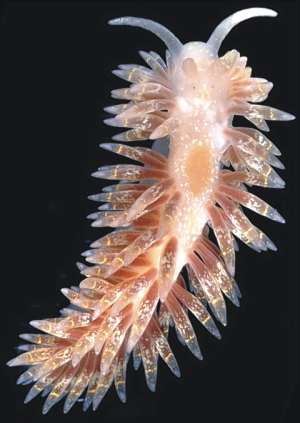
Spurilla macleayi
(Angas, 1864)
Order: NUDIBRANCHIA
Suborder: AEOLIDINA
Family: Aeolidiidae
DISTRIBUTION
Temperate Australia, from southwstern Australia to nthn New South Wales.
PHOTO
Tesselated Pavement, Pirates Bay, Tasman Peninsula, Sthn Tasmania, 15 February 1984. AM C141245 3 specimens together under rock at low tide. 10-22mm long alive. Photo: Bill Rudman
The shape is typical of most members of the Aeolidiidae, with a broad foot and tentacular anterior foot corners. The relatively short and fusiform cerata are numerous and lie closely packed to cover most of the dorsum behind the rhinophores except for the midline. The precardiac cerata are arranged in a double arch on each side while the cerata behind the pericardium are arranged in one or two single arches and then a series of up to 6 sloping single rows. The tapering rhinophores bear prominent tranverse wrinkles along most of their length. The notum behind the rhinophores and over the pericardium is clear of cerata. Behind the pericardium the clear space narrows but a distinct median gap between the cerata is retained all down the body. The foot, oral tentacles, rhinophores and head are translucent whitish but there can be varying degrees of orange or red pigmentation on the rhinophores and head region. On the head their can be an opaque white patch which is sometimes tinged with orange. Between the rhinophores and pericardium swelling there can be an opaque white diamond shape which can also be tinged with orange. A similar shaped patch can be found in the midline between each ceratal group. The pericardium is often covered by an orange patch. There are often white streaks down each side between the ceratal groups. In general the background colour of the animal, including the cerata, is dependent on the colour of the internal viscera so it can vary from a pale translucent orange or brown to a dark brown colour. The cerata have a characteristic subapical yellow ring. Below this ring there can often, but not always, be traces of two bluish-white rings. The bluish white rings are usually broken and can sometimes be reduced to irregular dashes and spots. There can sometimes be an orange tinge on the ceratal skin. The digestive gland reaches to about the level of the subapical yellow ring. Above this yellow ring the translucent white cnidosac is clearly visible.
Although it is reported to grow to 35mm in length, specimens seldom are larger than 20mm. It is usually found intertidally or in the shallow sublittoral, where it feeds on sea anemones. The eggs are large [see #12136] and give rise to direct developing young which hatch out of the egg mass as small crawling slugs.
References:
• Angas, G. F. (1864) Description d'especes nouvelles appartenant a plusieurs genres de Mollusques Nudibranches des environs de Port-Jackson (Nouvelle-Galles du Sud), accompagnee de dessins faits d'apres nature. Journal de Conchyliologie, 3, 12: 43-70, pls. 4-6.
• Burn, R.F. (1962) Descriptions of Victorian nudibranchiate mollusca, with a comprehensive review of the Eolidacea. Memoirs of the National Museum of Victoria, 25: 95-128.
• Burn, R.F. (1969) A memorial report on the Tom Crawford collection of Victorian Opisthobranchia. Journal of the malacological Society of Australia, 12: 64-106.
Rudman, W.B., 2004 (January 29) Spurilla macleayi (Angas, 1864). [In] Sea Slug Forum. Australian Museum, Sydney. Available from http://www.seaslugforum.net/factsheet/spurmacl
Related messages
-
Spurilla macleayi from northeastern New Zealand
From: Ian Skipworth, January 12, 2007 -
Re: Spurilla faustina? from New Zealand
From: Jeff Goddard, November 22, 2006 -
Spurilla faustina? from the South Island, New Zealand
From: Kimberley Seaward, November 21, 2006 -
Spurilla macleayi from New Zealand - with large eggs
From: Jeff Goddard, September 6, 2005 -
Anemone-feeding nudibranchs in South Australia
From: Dennis Hutson, February 5, 2005 -
Spurilla macleayi from Tasmania
From: Bill Rudman, February 9, 2004 -
Spurilla macleayi from Sydney
From: Bill Rudman, February 9, 2004 -
Spurilla macleayi - eggs & development
From: Bill Rudman, February 9, 2004 -
Spurilla macleayi - colour variation
From: Bill Rudman, February 9, 2004 -
The radula of Spurilla macleayi
From: Bill Rudman, February 9, 2004 -
Spurilla macleayi - pink eggs?
From: Rachel Przeslawski , February 9, 2004
